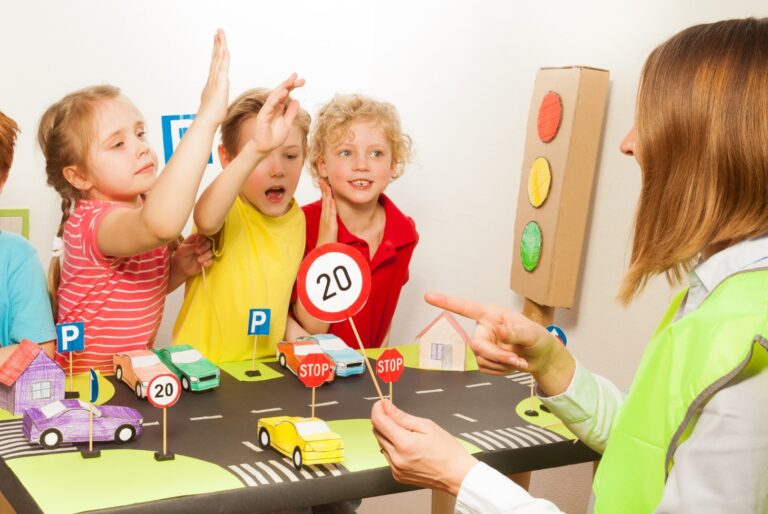Emotional Intelligent Early Childhood Educator
Teaching little ones requires much more than just academic knowledge. It demands a high degree of emotional intelligence and a heart-centered approach. Children at that age are like sponges, absorbing everything around them. The way you as an educator embody patience, kindness, and care makes a profound impact.
Heart-centered teaching means bringing your whole authentic self into the classroom. It’s about connecting with each child’s heart, not just their mind. When they sense your warmth and empathy, it creates a safe space for them to open up, explore, make mistakes, and grow.
Emotional intelligence allows you to attune to each child’s shifting feelings and needs throughout the day. You can validate their big emotions with acceptance rather than judgement. You model healthy self-regulation. Your calm, reassuring presence helps them navigate the tumultuous waters of childhood.
Emotional Intelligence in Teaching
Daniel Goleman, a pioneering researcher in this field, offers a compelling framework that can help you cultivate the emotional skills necessary to create a thriving classroom environment.
According to Goleman, emotional intelligence encompasses four key domains: self-awareness, self-management, social awareness, and relationship management. By developing these competencies, you can navigate the complex emotional landscape of early childhood education with greater ease, empathy, and resilience.
Self-awareness
Let’s start with self-awareness, the foundation upon which all other emotional intelligence skills are built. Self-awareness means you know what you’re feeling, you’re aware of your thoughts and how they shape your perceptions and impulses to act. When you’re attuned to your thoughts and emotions, you can recognize how they influence your teaching style, decision-making, and interactions with students and colleagues. This awareness allows you to regulate your reactions, respond thoughtfully to challenges, and model emotional maturity for your young learners.
Self-management
Closely linked to self-awareness is self-management, the ability to channel your emotions in a positive and productive manner. As an educator, you’ll inevitably face stressful situations that test your patience and composure. By cultivating adaptability, maintaining a focus on personal and professional growth, and embracing a positive outlook, you’ll be better equipped to navigate these challenges with grace and resilience.
| Self-awareness • Emotional self-awareness | Self-management • Emotional self-control • Adaptability • Achievement orientation • Positive outlook |
| Social awareness • Empathy • Organizational awareness | Relationship management • Influence • Coach and mentor • Conflict management • Teamwork • Inspirational leadership |
Daniel Goleman’s four domains of emotional intelligence
Social Awareness
Emotional intelligence isn’t just about managing your emotions; it’s also about understanding and connecting with others. That’s where social awareness comes in. Social awareness means you not only know how the person thinks and how they feel, but you care about them. When you approach your students, their families, and your colleagues with empathy and a keen understanding of their perspectives, you foster a classroom climate of trust, respect, and open communication. By remaining attentive to the social dynamics within your school or center, you can build collaborative relationships that support your students’ growth and well-being.
Relationship Management
Relationship management is about how well you handle conflicts. Can you keep yourself calm and listen to the other person? Are you being an effective communicator?
As an emotionally intelligent educator, you have the power to influence and inspire those around you. Whether you’re guiding a student through a difficult moment, mentoring a colleague, or working collaboratively with a team, your ability to manage relationships effectively is key to creating a positive and productive learning environment.
Unlike IQ, emotional intelligence can change. It’s learned and learnable at any point in life. Emotional intelligence is a set of abilities. Each of us has strengths and limitations across that spectrum, and it’s essential to identify areas where we can improve. Moreover, emotional intelligence is predicted to be the number one skill in future jobs, making it all the more crucial to foster its development in our youth.
Active Listening
One common challenge in emotional intelligence is poor listening. Often, we focus on what we want to say rather than truly listening to the other person. We may interrupt them, failing to fully understand their perspective.
Active listening is a communication skill that involves concentrating, understanding, and responding to what is being said. It involves giving your full attention to the speaker, not just hearing their words but also seeking to understand their thoughts, feelings, and perspectives.
When you actively listen to your students, you create a safe and supportive environment where they feel valued and heard. This encourages them to express themselves more openly, fostering their language development and self-confidence.
Respectful Communication
By demonstrating active listening, you are showing your students what respectful communication looks like. They learn to wait their turn, to make eye contact, and to respond appropriately. These are essential social skills that will help them build strong relationships and navigate interpersonal challenges as they grow older.
If you find yourself struggling with this aspect of emotional intelligence, consider making a conscious effort to change. Start by allowing your students to express themselves fully without interruption. Then, try to paraphrase what they’ve said to ensure you’ve understood their meaning. Only after you’ve demonstrated that you’ve heard and understood them should you share your thoughts and opinions.
| Key Elements of Active Listening | |
| Paying full attention | Give the speaker your undivided attention and focus on what they are saying. |
| Showing interest | Use body language and verbal cues to show you are engaged, such as maintaining eye contact, nodding, and using facial expressions. |
| Avoiding interruptions | Refrain from interrupting the speaker or preparing your response while they are still talking. |
| Reflecting | Mirror back what you hear to ensure you have understood correctly. You can paraphrase or summarize their main points. |
| Clarifying | Ask questions to gain a better understanding or to obtain more information. |
| Providing feedback | Offer thoughtful responses that show you have genuinely considered what the speaker has said. |
| Being non-judgmental | Listen with an open mind, even if you disagree with what is being said. |
By modelling this behavior, you’ll not only improve your own emotional intelligence but also teach your students the value of empathy and effective communication. These skills will serve them well throughout their lives, both in their personal relationships and future careers. As the job market continues to evolve, the demand for emotionally intelligent individuals will only grow, making your role as a teacher even more vital in preparing your students for success.
Developing emotional intelligence is a lifelong journey, but it’s one that yields immeasurable rewards for both you and your students. By cultivating four domains of emotional intelligence, you’ll be better prepared to handle the emotional demands of teaching, forge meaningful connections with your students and their families, and inspire a love of learning that will last a lifetime.
Let’s conclude with Dr. Gabor’s view of the importance of connection in the early years.

Klavdija Svet, author of Elevate to Educate
Elevate your teaching skills and stay ahead of the curve! Receive our monthly Insights, packed with professional development opportunities, classroom inspiration, and the latest trends in education. Don’t miss out on the chance to take your teaching to the next level. Subscribe now!







